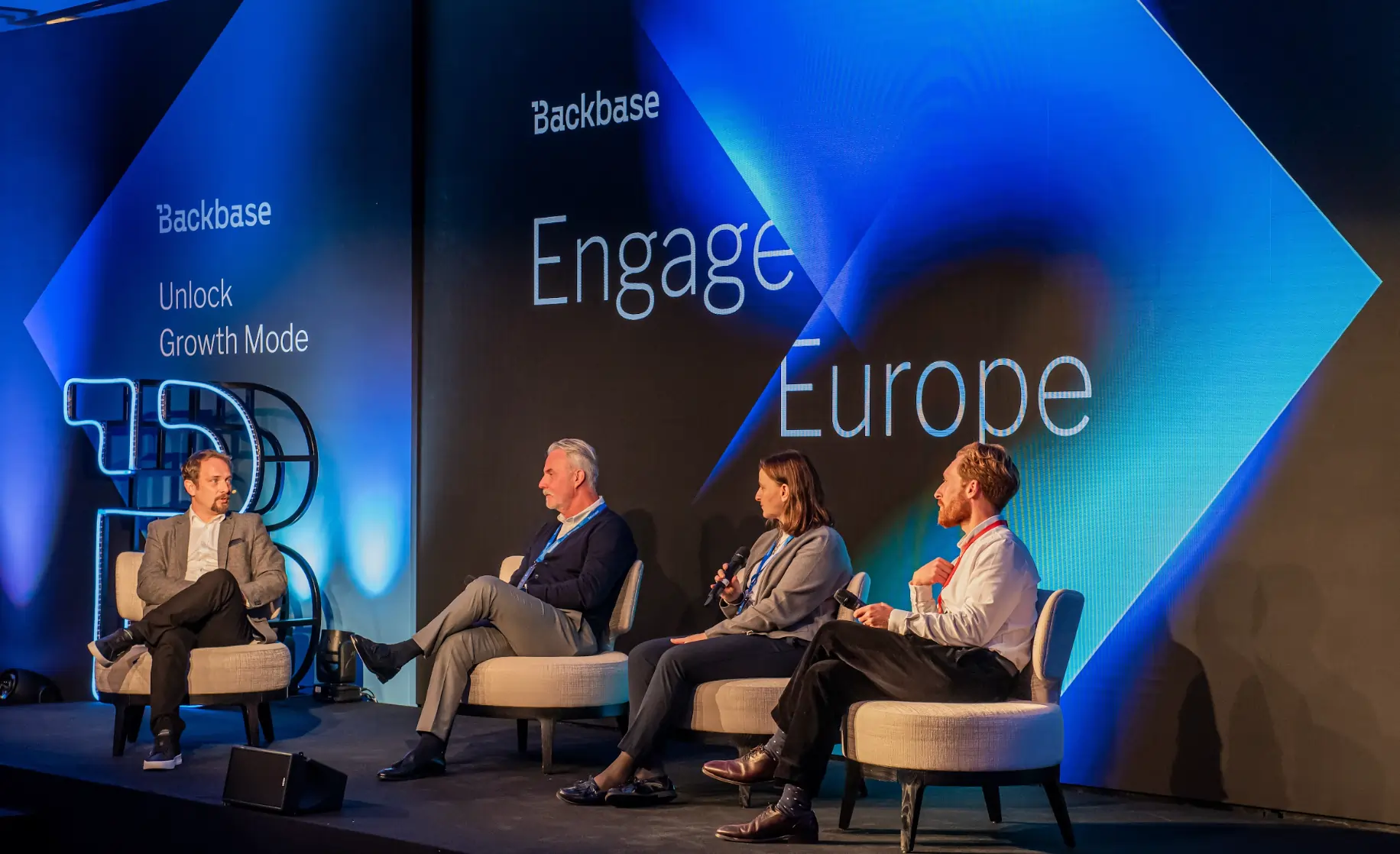At Backbase ENGAGE Europe 2025, building societies and mutuals took center stage in one of the event's most anticipated sessions. Jonathan Stallard, Regional Director UK & Ireland at Backbase, moderated a panel featuring three leaders navigating the unique challenges of member-owned financial institutions in an increasingly digital world: Simon Broadley, CEO of Furness Building Society; Susanne Parry, COO of Cumberland Building Society; and Ben Nadel, Co-Founder of Woodhurst.
The conversation explored what it takes to preserve the values that make mutuals special, while competing in a market dominated by scale-driven banks and agile fintechs.
The conversation explored what it takes to preserve the values that make mutuals special, while competing in a market dominated by scale-driven banks and agile fintechs.
The mutual advantage - and the challenge
Mutuals operate from a fundamentally different position than traditional banks. They're member-owned, locally focused, and built on relationships that span generations. That's their strength. But in a digital-first world, those same characteristics create unique pressures.
The panel made one thing clear: mutuals aren't just competing with other building societies anymore. They're competing with neobanks that launch products in weeks, Big Tech companies that own the customer relationship, and traditional banks with massive technology budgets.
Simon Broadley framed the challenge perfectly. As CEO of Furness Building Society, he's laser-focused on serving members through their shared culture and values. But he's also realistic about what it takes to deliver modern digital experiences. "The cost associated with building and managing in-house systems can be massive, even for a mid-sized entity," he explained. That reality forced Furness to make a strategic choice: partner with specialists rather than try to build everything themselves.
Some might look at this as a lack of ambition. But, it’s really about focusing resources where they matter most - on members, not on maintaining infrastructure.
The strategic choice: build or partner
The "build versus buy" debate came up repeatedly, but not in the way you'd expect. The panel wasn't debating whether to modernize. They were discussing how to do it without losing what makes mutuals different.
For Furness, the decision came down to understanding their strengths. They excel at demonstrating their culture and values. They know their members. They understand their local market. What they don't need to be experts in is building core banking platforms from scratch.
Broadley's approach is what Backbase calls "buy plus build" - purchase a foundational platform with proven journeys, then build on top for differentiation. An approach that allows you to focus on accelerating your ability to serve members.
Cumberland Building Society faced similar decisions. As COO, Susanne Parry leads an organization that needs to balance tradition with transformation. The tension isn't abstract - it plays out in every technology decision, every process change, every conversation about the member experience.
Ben Nadel brought the fintech perspective to the conversation. As Co-Founder of Woodhurst, he's seen firsthand how modern technology can enable smaller institutions to compete. But he was also clear-eyed about the trade-offs. Speed matters. Agility matters. But so does trust, stability, and understanding your members deeply.
The member experience in a digital world
As banking becomes digital, what keeps members connected to their mutual?
This is the existential question for building societies. Digital banking, by definition, removes friction. It streamlines. It automates. It makes transactions invisible. But for institutions built on relationships, is that actually what members want?
The panel's answer: it depends on the context.
Members don't want friction for friction's sake. They don't want to visit a branch to check their balance or wait days for a simple transaction. But they do want to know their mutual understands them and their needs. They want personalized service when it matters. They want the option of human help when they need it.
The challenge is using digital channels to deepen relationships, not replace them. That means using data to anticipate member needs. Building experiences that feel personal, not generic. Creating moments where the member thinks, "they know me."
Parry emphasized this point throughout the discussion. Cumberland isn't adding digital friction to force branch visits. They're building secure, seamless experiences powered by smart data. The goal is to use every digital interaction - every transaction, every touchpoint - to better understand, anticipate, and serve member needs.
That's fundamentally different from viewing digital as a cost-reduction exercise.
The technology trap
The panel didn't sugarcoat the technology challenges mutuals face. Legacy systems. Limited budgets. Aging infrastructure. These are real constraints.
But the bigger trap isn't the technology, but the approach.
Too many mutuals are trying to patch their way to the future. They're adding point solutions to fragmented systems. They're customizing core platforms that weren't designed for customization. They're spending a large portion of their budget on maintenance instead of innovation.
That right there is an architecture problem.
Broadley was direct about this. Furness looked at their options and realized that trying to build everything in-house would drain resources without delivering better member outcomes. They needed a partner who understood banking, had proven journeys, and could integrate with their existing systems.
The takeaway: you don't have to do it all alone. Find the best solution for your business-specific priorities.
Competing without losing identity
This was perhaps the most important theme of the discussion. How do mutuals modernize without becoming just another bank?
The answer is finding ways to use technology in service of member relationships.
Neobanks can out-tech traditional mutuals. Big banks can outspend them. But neither can match the depth of relationship, local knowledge, and member-first culture that defines building societies.
The competitive advantage doesn't come down to speed alone. It's speed plus trust. Innovation plus stability. Digital capability plus human connection.
Several points became clear:
Mutuals that try to compete on technology alone will lose. The budget math doesn't work.
Mutuals that ignore technology will become irrelevant. Member expectations have changed.
Mutuals that use technology to amplify their core strengths will win. That's where the opportunity sits.
The panel made it clear: innovation matters. But so does trust. The institutions that pair both - modern technology with member-centric culture - will thrive in this new era.
The path forward
So what should mutuals actually do?
The panel offered several clear action points:
Stop trying to build everything yourself.
The cost is too high, the risk is too great, and the opportunity cost is massive. Find partners who understand your constraints and can accelerate your transformation.
Focus on member outcomes, not technology features.
Don't modernize for the sake of modernization. Modernize to serve members better. Every technology decision should start with "how does this help members?"
Use data to deepen relationships.
Digital banking generates massive amounts of data. Use it to anticipate needs, personalize experiences, and create moments where members feel understood.
Preserve what makes you different, and special.
Your culture, values, and member-first approach are competitive advantages. Technology should amplify those strengths, not replace them.
Move faster than you think you can.
The pace of change isn't slowing down. Mutuals that wait for perfect plans will fall further behind. Start small, ship fast, learn, and iterate.
Invest in capability, not just technology.
Platforms matter, but don’t forget about your people. Build teams that understand both the business and the technology. Create a culture that embraces change.
What mutuals should focus on now
The urgency is real. Mutuals face a choice: modernize in a way that preserves their identity, or watch member expectations drift toward institutions that can deliver digital experiences.
Three priorities stand out:
Member experience.
Map the entire member journey. Find the friction points. Identify where digital can help and where human touch matters. Build experiences that feel personal, even at scale.
Platform architecture.
Stop patching fragmented systems. Move to unified platforms that can support modern experiences, integrate easily, and evolve with changing needs. The technology exists. The question is whether you'll move fast enough.
Speed to market.
Time is the constraint. Mutuals that can launch products in weeks instead of months will capture opportunities others miss. That requires both technology and process changes.
The time to act is now. Mutuals have everything they need to win - trust, member relationships, local knowledge, and a culture built on service. What they need is the technology foundation to compete.
The institutions that move first, partner smart, and stay focused on members will shape the next era of mutual banking.
It’s time to get to work.


